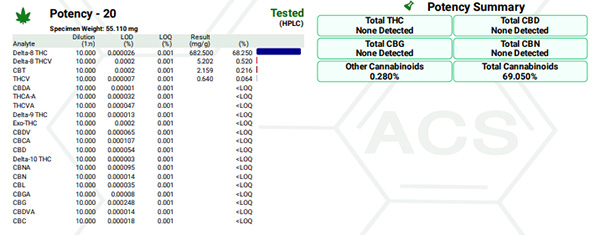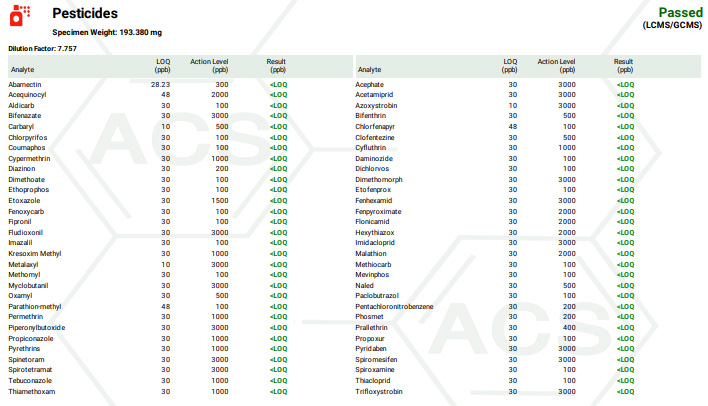No products in the cart.
What is a COA
In the hemp and cannabis industry, a lab-tested product is the gold standard for everything a company produces- whether it’s edibles or vaping, each product has to have a certain degree of testing for peace of mind and personal safety. A COA; which stands for Certificate of Analysis, is the testing certificate you want to look for when choosing the right product for you. It contains all of the necessary information for potency and more so you can choose specific hemp products for your specific needs, as well as verify the levels of heavy metals and other contaminants in a product to be at compliant amounts. In this article we’ll break down a Certificate of Analysis and show why it’s so important to have these on every product.
Table of Contents
Breakdown of COAs
Potency
Heavy Metals
Mycotoxins
Residual Solvents
Pesticides
Breakdown of COAs
There are a few different tests in a COA, and the most common set of tests is known as a Full Panel Lab Report. This consists of 5 different tests in one report. The list includes testing for Potency, Heavy Metals, Mycotoxins, Residual Solvents, and Pesticides. These are all tested for either parts per million or parts per billion to ensure compliant products and no harmful contaminants in the end product. When looking for contaminants like Heavy Metals or Pesticides, you will want the actual testing to match or be below the LOQ, or Limit of Quantification, as this is the defining factor of whether a product has unsafe levels of contaminants in it.
Potency
Potency is the percentage breakdown of total Cannabinoids in a hemp or cannabis product. Most labs in the USA are DEA certified and test for a wide range of cannabinoids like CBD, Delta 8 and 9 THC, CBG, CBN, and many more compounds that are still being discovered with testing even today. We use New Bloom Labs, which can quantify almost 20 different cannabinoids such as THCVA and CBL. Potency testing will list the percentage of cannabinoids as well as the milligram amount of cannabinoids. When a product tests at 65% total active cannabinoids, that means there are 650mg of cannabinoids in each product, and so on with each individual cannabinoid percentage-to-milligram. This is an easy way to find out your dosage for a product and of course finding out how strong a product is to suit your needs.
Heavy Metals
Testing for heavy metals is a critical step in a full panel lab report. Heavy metals can enter the process even during the growth of the plant as it absorbs nutrients from the soil. Some of the heavy metals tested for in each report are Arsenic, Lead, Cadmium, and Mercury. Each report will state the LOQ and your tested product’s result, and whether or not it passed for safety with a PASSED or FAILED. Only use products that have PASSED their heavy metal lab report and other steps of the full panel process.
Mycotoxins
Mycotoxins are toxic compounds produced by mold and fungi. These harmful compounds have been linked to severe health impacts like cognitive decline and even cancer, so ensuring that products you’re consuming (especially organic ones like hemp flower) are free of these harmful contaminants. Some of the Mycotoxins tested for in each lab are various types of Aflatoxin and Ochratoxin. Mycotoxins once again come with a PASSED or FAILED status for each test and we only recommend using PASSED lab-tested products.
Residual Solvents
Residual Solvents are an important step in the full panel lab testing procedure because a lot of black market cannabis and hemp concentrates are made with solvents and are not properly purified in the end product, without lab-testing there will be no way to verify the safe levels of residual solvents in a product before using it. These residual solvents can be a wide range of contaminants like Ethylbenzene, Acetone, Ethanol, and dozens more. These are once again tested against the LOQ which is usually in the PPM or PPB concentration.
Pesticides
Pesticides are harmful contaminants that can be introduced into the product while it is still in the growing plant form, which affects stages from flower to concentrates. Some growers may use synthetic and harmful pesticides on their crops to get rid of pests or yield a healthier plant. These in turn pollute the plant, making it unsafe for consumption and processing. There are a few different types of pesticides: insecticides, herbicides, bactericides, larvicides, and fungicides. Some pesticides that are tested for in a full panel lab report are Acephate, Boscalid, and Fipronil. These will be tested against the LOQ and must be equal or under the allowed amount to pass.
Conclusion
Given the fact there are plenty of moving parts and a lot of information that goes into these full panel reports, there’s a definite reason why these are the baseline testing standard for hemp and cannabis products, from flower to edible and everything in between. When guests are looking for the right hemp product for them, they also want to have the peace of mind what they’re consuming has been lab-tested and the information is readily available, full transparent, and works as intended. There still may be variations and untested cannabinoids that are still being discovered, but legalization of hemp has brought a level of rigorous standards that the black market level lacks entirely. We hope as legalization efforts for cannabis continue we will see a reliable standardization for testing safe and compliant products, and we look forward to the advances in technology this industry will enjoy along with it!




